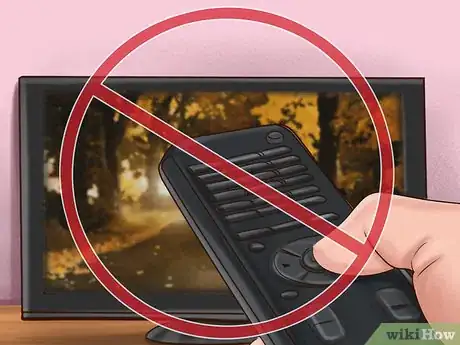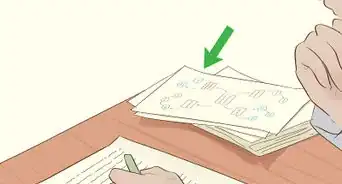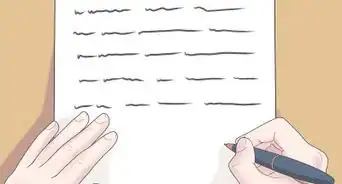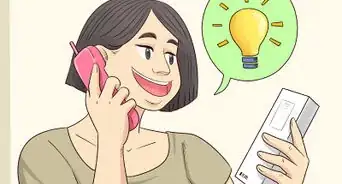This article was co-authored by Dan Klein. Dan Klein is an improvisation expert and coach who teaches at the Stanford University Department of Theater and Performance Studies as well as at Stanford's Graduate School of Business. Dan has been teaching improvisation, creativity, and storytelling to students and organizations around the world for over 20 years. Dan received his BA from Stanford University in 1991.
There are 10 references cited in this article, which can be found at the bottom of the page.
wikiHow marks an article as reader-approved once it receives enough positive feedback. In this case, 86% of readers who voted found the article helpful, earning it our reader-approved status.
This article has been viewed 253,668 times.
You can use your imagination to help you through a number of situations. For instance, you can use it to help solve a problem or to help unlock your creativity for a project. Imagination is also fun when you can use it with siblings or friends. You can even use it to take mini-vacation in your mind, helping you to relax in the middle of life's everyday problems.
Steps
Using Imagination to Solve a Problem
-
1Think about a scenario without failure. That is, when you are thinking about a problem or situation, imagine that you cannot fail. Think about options you normally wouldn't consider because you think they are risky. Think about what resources you would use if you could use anything, including people. How would you solve the problem if you had any option at your disposal?[1]
- This exercise can open you up to different solutions. You may not be able to implement the exact solution you come up with, but you might be able to come up with a good substitute that you hadn't thought of before.
-
2Challenge assumptions. Sometimes the best way to use your imagination to find a creative solution is to break down assumptions you've made about the problem. However, first you need to make a list of what those assumptions are.[2]
- For instance, maybe your problem is that you need to fund a project, and the company doesn't have enough money. You've likely made the assumption that the project has to take a certain amount of money. You also probably assumed that the money needs to come from within the company.[3]
- However, try to challenge these ideas. Maybe the project could cost less if you took a different approach. On the other hand, maybe you could get funding from elsewhere, such as a donor or even a grant if it's a community project. Try to think outside the box.
Advertisement -
3Spend some time alone. While it's tempting to immediately throw your problem out to a group, sometimes it's best to spend some time thinking about it yourself. Turn off the distractions, such as the television and the internet. Focus solely on the problem at hand.
- Take a break from the problem and change your environment. Sometimes that’s all it takes for inspiration to strike.
-
4Stop the criticism. You're probably your own worst critic, which means you may stop yourself before you get to a solution. When a new idea pops into your head, don't immediately write it off as dumb. Take some time to consider it. You may be able to develop it into a better idea, one that becomes the perfect solution for your problem.
-
5Brainstorm on your idea. Brainstorming can help open up your imagination so you can see different solutions. You can brainstorm in a group or alone; either way can help increase the number of ideas you come up with.[4]
- For instance, you can try freewriting. Write your problem at the top of a page. Once you do that, just begin writing. Don't criticize or censor, just write whatever comes to your mind. Using this technique can help get your ideas flowing, as well as help you make connections you hadn't thought of. When you've spent at least 10 or 15 minutes freewriting or when you feel like you've reached a stopping point, look back over your writing and highlight or circle anything that might be useful.[5]
- Another way to brainstorm is to make a concept tree. For instance, you can start with your problem in the center within a circle. Use a line to branch off the main idea with another idea. Group like ideas together with lines. Start new branches for new ideas. This technique is also good for making connections, especially since you can represent it visually.[6]
- In a group, be sure to brainstorm before you get together so you have some time to think. Make sure to censor any criticism, as that can stop people from bringing up ideas. The leader can throw out a topic or problem, and then the group can bounce ideas off of each other.[7]
Using Imagination to Unlock Creativity
-
1Try prompts. Whether you're trying to write, paint, or solve a problem, prompts can get you thinking. Sometimes just moving past the blank page is the hardest step, and a prompt will at least get you moving. Prompts don't have to be written. They can be visual, such as a painting or photograph, or even auditory, such as a piece of music.
- For instance, maybe you are trying to paint a picture of a depressing time in your life, but you're having trouble getting started. Putting on the right song could help you get in the mood.
- Another example is a writing prompt, where someone else sets up a scenario or a question that you write on, such as "You find yourself in a dark room with only one window. You have a pencil in your hand and no shoes. How did you get there?" You can find writing prompts in books on writing and on writing websites.
- Find prompts that involve the 5 senses. Each sense may make you think different feelings or memories.
-
2Take some time to fully notice. That is, you may often go through your day without really noticing the things around you. You drink your morning coffee without noticing its deep flavor or walk by your office's landscape without noticing the lilies. Try to be more aware of your surroundings. When you notice more, it can spark your imagination, giving you a new perspective.
-
3Try something new. If you always do the same thing, you'll get stuck in a rut. However, just trying a new technique or looking at something from a different perspective can help unlock creativity. Sometimes all it takes is literally moving yourself around the room, such as looking at a project from the floor or from above it. Other times, you may need to take a different approach to encourage your imagination to start running, such as learning a new way to paint or a different way to sew a pattern.[8]
- Another way to shake things up is to have different experiences. For instance, maybe go to the symphony if you've never been or try a new food. You never know what connections your brain is going to make.
-
4Focus on the process. That is, instead of beating your head against the wall to get a predetermined finished product, let the process help define what your project becomes. It's through the process that you can explore ideas and take different routes; if you give into that process, you may come up with something even better than you expected. Another way to say this idea might be "Don't be afraid to deviate from your outline."[9]
- Plus, even if you decide you don't like what you end up with, you can use what you learned on the next project.
-
5Skip the perfectionism. If you're a perfectionist, you know that you can be so focused on not making a mistake that you may not finish what you start or you're always unhappy with how it turns out. Perfectionism is a form of self-criticism, and therefore, it can stop you from moving forward with a project or trying something new. Therefore, you should try ways to slow down your perfectionist nature.[10]
- Remind yourself that making a mistake is not the end of the world. If you paint a line in the wrong place on your painting, it can be fixed. Alternatively, maybe it will help you take a new direction you didn't even think of. Making a mistake is a natural part of life.[11]
- Wait to decide. Sometimes, when you're in the middle of a project, you may decide you want to scrap it and start over. However, give it a chance. Finish the project, and then sleep on it. You may decide you like it better in the morning or that you can do something to fix it.
- Don't make it all or nothing. Remind yourself that even if what you end up with is less than perfect, it can still be good.[12]
-
6Give yourself enough time. Working under a deadline can be exhilarating, spurring you on to creativity. However, it can also be stressful, and if you get stressed out, it can stifle your creativity. Know how much time you, personally, need to work on something, and give yourself enough time to do it. Set out that time so you can focus solely on your project.[13]
Employing Imagination to Relax
-
1Get comfortable. This exercise will probably work better if you are in a comfy chair. However, if you can't do that, just try to get as comfortable as possible where you are. Settle down in your chair or even sit on the floor if you want.[14]
-
2Encourage your focus. While you can use this technique in a busy area, you'll probably find it easier to focus if you can step away to a quiet spot. In addition, it's best to close your eyes so you can cut out some of the distractions.[15]
-
3Set up your scene. You can pick any place that makes you happy. Try a place you went on vacation, someplace you've seen through pictures, or even a fantasy place. The important thing is to choose a place that makes you happy.[16]
-
4Use your senses. Now, use each of your senses to bring up the reality of that place. Think about what it smells like, what the air tastes like. Think about how it feels under your feet and what the weather feels like on your skin. Bring up the sounds of the place, from ocean waves to the wind to kids shouting in the distance. Finally, don't forget the visuals! Think about everything you'd see if you were there.[17]
-
5Lose yourself. Try to completely block out your surroundings. Focus solely on the world you are trying to create, letting your body feel itself in that place instead of where you are. Stay in that image until you feel yourself relaxing.[18]
Expert Q&A
-
QuestionHow do you deal with the unexpected?
 Dan KleinDan Klein is an improvisation expert and coach who teaches at the Stanford University Department of Theater and Performance Studies as well as at Stanford's Graduate School of Business. Dan has been teaching improvisation, creativity, and storytelling to students and organizations around the world for over 20 years. Dan received his BA from Stanford University in 1991.
Dan KleinDan Klein is an improvisation expert and coach who teaches at the Stanford University Department of Theater and Performance Studies as well as at Stanford's Graduate School of Business. Dan has been teaching improvisation, creativity, and storytelling to students and organizations around the world for over 20 years. Dan received his BA from Stanford University in 1991.
Improvisation Coach Give yourself permission to say yes. When you're faced with something unexpected, open yourself to the possibility that there's something valuable there. Instead of shooting the idea down, try going with it to see what happens.
Give yourself permission to say yes. When you're faced with something unexpected, open yourself to the possibility that there's something valuable there. Instead of shooting the idea down, try going with it to see what happens. -
QuestionShould I let my imagination distract me or should I try to pay more attention?
 Paul Chernyak, LPCPaul Chernyak is a Licensed Professional Counselor in Chicago. He graduated from the American School of Professional Psychology in 2011.
Paul Chernyak, LPCPaul Chernyak is a Licensed Professional Counselor in Chicago. He graduated from the American School of Professional Psychology in 2011.
Licensed Professional Counselor Be careful not to use your imagination as a means of escape from reality. Try focusing on your surroundings more and naming things in your environment in order to bring you back to the present moment.
Be careful not to use your imagination as a means of escape from reality. Try focusing on your surroundings more and naming things in your environment in order to bring you back to the present moment. -
QuestionWhen do people normally use imagination to solve problems?
 Paul Chernyak, LPCPaul Chernyak is a Licensed Professional Counselor in Chicago. He graduated from the American School of Professional Psychology in 2011.
Paul Chernyak, LPCPaul Chernyak is a Licensed Professional Counselor in Chicago. He graduated from the American School of Professional Psychology in 2011.
Licensed Professional Counselor Imagination allows us to explore ideas of things that are not in our present environment or do not exist yet. You use it all the time whether you are problem-solving or not. Daydreaming is a clear example of using your imagination. We do it all the time for mundane tasks like driving a car and thinking about how to get to a location before we even leave the house.
Imagination allows us to explore ideas of things that are not in our present environment or do not exist yet. You use it all the time whether you are problem-solving or not. Daydreaming is a clear example of using your imagination. We do it all the time for mundane tasks like driving a car and thinking about how to get to a location before we even leave the house.
References
- ↑ http://www.asha.org/associates/Unlocking-Your-Imagination/
- ↑ http://99u.com/articles/31987/how-to-apply-lateral-thinking-to-your-creative-work
- ↑ http://99u.com/articles/31987/how-to-apply-lateral-thinking-to-your-creative-work
- ↑ http://writingcenter.unc.edu/handouts/brainstorming/
- ↑ http://writingcenter.unc.edu/handouts/brainstorming/
- ↑ http://writingcenter.unc.edu/handouts/brainstorming/
- ↑ http://writingcenter.unc.edu/handouts/brainstorming/
- ↑ http://www.forbes.com/sites/dorieclark/2012/04/03/three-ways-to-foster-creativity-in-your-organization/2/
- ↑ http://www.earlychildhoodnews.com/earlychildhood/article_view.aspx?ArticleID=349
- ↑ http://www.uncommonhelp.me/articles/overcoming-perfectionism/
- ↑ http://www.uncommonhelp.me/articles/overcoming-perfectionism/
- ↑ https://www.psychologytoday.com/blog/depression-management-techniques/201203/handling-perfectionism
- ↑ http://www.earlychildhoodnews.com/earlychildhood/article_view.aspx?ArticleID=349
- ↑ http://www.dummies.com/how-to/content/how-to-use-your-imagination-to-destress.html
- ↑ http://www.mayoclinic.org/healthy-lifestyle/stress-management/in-depth/relaxation-technique/art-20045368?pg=2
- ↑ http://www.dummies.com/how-to/content/how-to-use-your-imagination-to-destress.html
- ↑ http://www.mayoclinic.org/healthy-lifestyle/stress-management/in-depth/relaxation-technique/art-20045368?pg=2
- ↑ http://www.dummies.com/how-to/content/how-to-use-your-imagination-to-destress.html















































































